This post may contain affiliate links.
Sri Lanka is famous as a fruit-producing destination and you will certainly sample some amazing and delicious Sri Lankan fruits during your stay. Expect a selection of fruit on your hotel’s buffet every morning, each perfectly ripe and sweet from the fertile soil, abundant water, and tropical sun. Sri Lankan fruits are tropical, of course, and similar to those found in all other tropical regions but there are a few fruits Sri Lanka is particularly famous for. Don’t forget to visit a fresh produce market during your time on the island to check out and maybe buy a few Sri Lankan fruits of your own. You will also find little fruit stalls lining the roads, don’t be afraid to stop and buy, your driver should be able to negotiate for you.

Sri Lanka, Fruit
In Sri Lanka fruit is very commonly eaten and you’ll likely see an array of delicious tropical fruits, such as pineapple, papaya (pawpaw), mango and bananas. Sri Lanka also produces some less well known fruit, like jackfruit and mangosteen. The jackfruit (Artocarpus heterophyllus) is the national fruit of Sri Lanka and is the biggest fruit in the world. Jackfruit is also the national fruit of Bangladesh.
This post is about the most famous Sri Lankan fruits, fruits you will find in Sri Lanka and fruits that are grown in Sri Lanka. For many tourists, the tropical fruits found in Sri Lanka will be a totally new and delicious experience.
We also give you Sri Lankan fruits’ names and pictures, growing, and harvested.
Is it Safe to Eat Fruit in Sri Lanka?
Don’t be too nervous about eating fruit in Sri Lanka, most require peeling so should be safe to eat.
You will also find the fruit in smoothies, milkshakes and cocktails, use common sense, but we’ve never had any tummy problems after eating fruit in Sri Lanka.
We usually carry a small Swiss Army knife (buy one here on Amazon) to peel any fruit we buy.
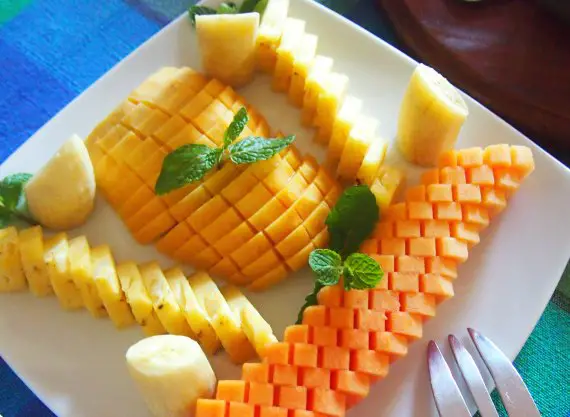
Trying the food on offer on this beautiful island has to be one of the best things to do in Sri Lanka, so come prepared to try all of these new, exotic, tropical fruits along with rice and curry, hoppers, kotu roti and amazing seafood.
Fruit Markets in Sri Lanka
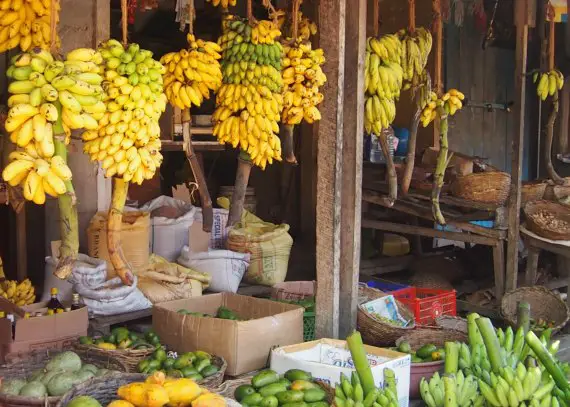
We highly recommend a visit to the old Dutch markets in Galle, the southern capital, where you will find succulent fruit displays.
Don’t miss out on the nearby fish, vegetables and spice markets too.
Most tourists can easily visit from the beach resorts by bus, train, car or tuk-tuk.
Roadside Fruit Stalls in Sri Lanka
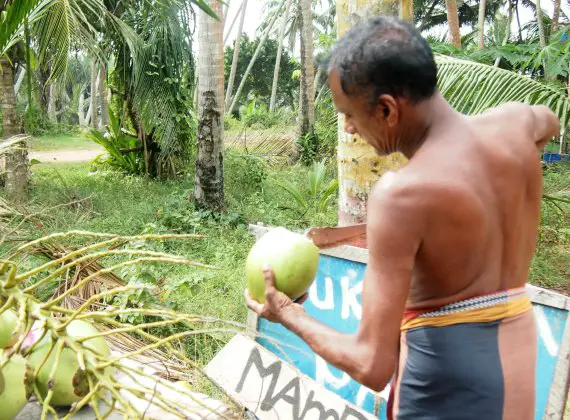
You’re likely to see small roadside fruit stalls. These might be run by a home-owner or small farmer.
Ask your tuk tuk or taxi driver to stop and he should be able to negotiate price for you. Drinking coconuts are a great choice!
Famous Sri Lankan Fruits
The most famous of the Sri Lankan fruits is surely the mangosteen. So partial was Queen Victoria to them, that according to legend, she asked for them to be specially shipped to her direct from Sri Lanka and rewarded the delivery with one hundred pounds.

Sri Lanka is also famous for King Coconut (and yes, coconuts are indeed a fruit) known as Thaembili locally. King coconut (Cocos nucifera) is native to Sri Lanka and has the most delicious and electrolyte rich coconut water for drinking. King coconut water is used medicinally in Ayurveda so is much prized. You’re likely to find King Coconut vendors on Sri Lanka’s tourist beaches or on the roadside.
Mangosteens, The Queen of Sri Lankan Fruits

A hard purple case holds a sweet secret, white segments, each with its own pip. Not the easiest fruit to eat, but absolutely delicious.
Mangosteen is the national fruit of Thailand and is native to Southeast Asia.
Durian

Mangosteen is known as the queen of fruits, durian is the king.
Only a small area in southern Sri Lanka produces durian and the season is normally July-August although it is highly weather dependent.
Durian is famous for its bad smell but it is a fruit that really gets people excited, so much so that you’ll find whole websites devoted to the durian fruit. Durian is native to Southeast Asia but is grown in Sri Lanka and exported from Sri Lanka. Durian season in Sri Lanka (northern hemisphere) is July to August, depending on the weather in any given year.
Custard Apples, Anoda, Sugar Apple, Katu Atha or Sweetsop
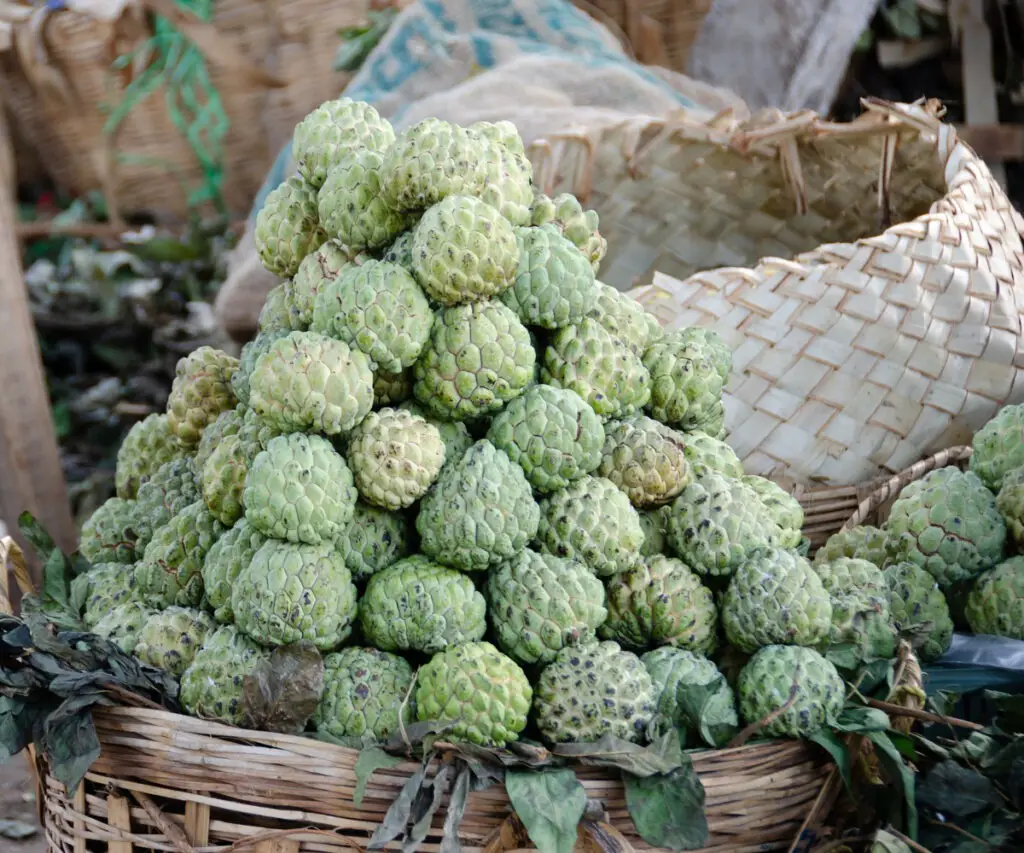
Sri Lanka is particularly famous for sweet, soft, custardy custard apples. Their hard knobbly skin hides the soft sweet pulp inside, this can be eaten with a spoon, chilled. Custard apple flesh also makes a delicious drink. There are four varieties of custard apple grown in Sri Lanka and they each have a unique flavour.
The custard apple (Annona reticulata) is thought to have originated in the Andes of South America and was possibly introduced to Sri Lanka by the Spanish. Custard apple is a relative of the soursop (Annona muricata), but is not the same fruit.
Custard apple is closely related to Cherimoya (Annona cherymoya) and is also known as wild sweetsop.
Jack Fruit, the Biggest Sri Lankan Fruits

Jack, the biggest fruit in the world, grows abundantly in Sri Lanka, in fact, jackfruit, Artocarpus heterophyllus, is the national fruit of Sri Lanka and possibly the fruit Sri Lanka is most famous for. Jackfruit is native to India.
When ripe it is bubble-gum sweet but immature fruits can be used to make Sri Lankan jackfruit curry.
We sampled this at the Villa Templeberg near Galle, where our chef picked and prepared jackfruit for an amazing evening of dining by candlelight and flaming torch in the tropical garden.
We used to grow jackfruit back in our garden in Queensland Australia. The climate is similar. The heaviest jack fruit recorded weighed in at a monstrous 275Kg.
What Does Jackfruit Taste Like?
A ripe jackfruit’s yellow flesh is very sweet and the flavour of Juicy Fruit chewing gum. It almost tastes like a fruit cocktail, combining sweet pineapple and banana. Jackfruit is also used unripe in curries in Sri Lanka.
Cashew Apple
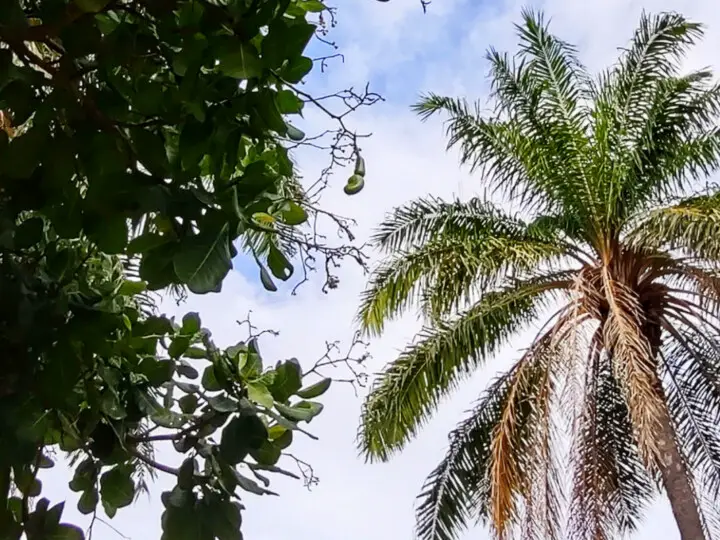
The cashew nut is widely grown and produced in Sri Lanka and the cashew apple is a by-product. It’s not good to eat, but in Goa, India, the apple (actually the swollen stem) is used to make a fiery alcoholic drink, cashew feni.
We have seen them being sold in markets and stalls in Antigua Guatemala, where women were selling them at the roadside. Maybe they were trying to catch out unsuspecting tourists or maybe they were selling it to make non-alcoholic cashew fruit juice.
Cashew trees grow in Sri Lanka and also in places with similar tropical climates, such as Far North Queensland, Australia
Bananas in Sri Lanka
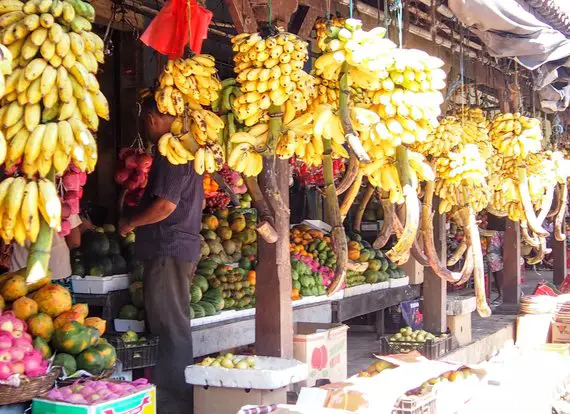
So many different types of bananas are grown in Sri Lanka! There are at least 29 varieties of banana grown in Sri Lanka and many of them are native or indigenous to the country. You will see tiny finger banana varieties and monstrous fruits and plantains hanging from roofs in huge bunches from small stalls. Bananas can be sweet or sour, red , green, and yellow in Sri Lanka.
Sri Lankan bananas fall into three main groups: mysore banana, kolikuttu banana and Cavendish banana.
Bananas were introduced to other tropical areas of South America by the Spanish, they originally came from Sri Lanka and South and Southeast Asia. Australia also has some native wild bananas.
Bananas do not grow on trees, they grow on a banana plant, which is a member of the ginger family. This post is about how bananas grow.
They come in red, green, almost-brown and traditional yellow. You will find a comprehensive guide to Sri Lankan bananas here.
Sri Lankan Mango

Mango is a common fruit in Sri Lanks and is my personal favourite fruit. The mango is the sweetest of the sweet and with a heavenly perfume. Many varieties of mango are grown in Sri Lanka. When perfectly ripe, mangos are best eaten in the shower to avoid the mess!
Try the different types of mango and see which is your favourite.
Mangos are a stone fruit of the tree Mangifera indica, a huge tree when mature, in cultivation it is kept short to allow easy harvesting. Mangos are native to northern India, but have been grown in Sri Lanka for centuries. Although mango is not endemic to Sri Lanka, it is endemic to the Indian Subcontinent. Mangos are grown in many parts of Sri Lanka, including Alawwa, Yakwila, Saliyagama, Malsiripura, Hunukubura, Rambe, Nakolagane, Anamaduwa, Kawanyankulama, Nanneriya. Sri Lanka also exports mango fruit to the Middle East, Europe, and Singapore. Mango season in Sri Lanka (northern hemisphere) is May to August, with mangos being at their peak in June.
Lychee

Lychee can be confused with rambutan but they aren’t the same fruit even if they look similar at first glance. Lychees are small round fruits with a nobbled skin and no spikes and contain a small seed inside.
White flesh inside between the skin and the seed is crisp and sweet although not as sweet as the rambutan some say.
Lychees grow on trees and there are several varieties, they are orange to red all over when ripe and should feel slightly soft to the touch. Unripe lychees may be red, but hard and sour. Lychees are seasonal, they are ripe for a few weeks in early summer, as are mangos. Other Sri Lankan fruits, like papaya, can produce year-round.
They can be found all over Southeast Asia and South Asia with Sri Lanka being an ideal place to grow them. During the season you’ll find street stalls selling lychees from Kandy to Colombo and down the coast towards Galle.
If you can’t get fresh ones you’ll find lychee juice, cans of lychees and even cocktails made from lychees across not just Sri Lanka but all of Asia.
Lychee, (Litchi chinensis), also known as litchi or lichi, is an evergreen tree of the soapberry family (Sapindaceae), cultivated for its sweet edible fruit. Lychee is native to Southeast Asia but is cultivated in Sri Lanka. Lychee is a seasonal fruit, the lychee is in season in early summer, from May to June usually. In the southern hemisphere lychee season is November and December usually. Lychee pips and unripe fruit are reportedly toxic to horses and even people.
Rambutan

Larger than lychees and said to be sweeter, this Sri Lankan fruit has a reddish skin with tiny hairs/spikes all over it. The seed in the middle can be cooked and eaten but this isn’t particularly common.
The Sri Lankan season for rambutan is normally May, June, and July where you’ll see stalls set up on the side of the road sell bunches and bunches of this wonderful fruit.
Rambutan doesn’t ripen off the tree so outside of picking season it is very hard to source them unless they came from an international source like Thailand or Indonesia which make up the bulk of the world’s exporters.
Rambutans (Nephelium lappaceum) grow in Sri Lanka but are native to Southeast Asia, Indonesia and Malaysia. In Sri Lanka, there are large rambutan orchards in Malwana, a town 21 Km west of Colombo. Rambutan is sold at most of the fruit markets in Sri Lanka at the correct time of year. Rambuttan, like lychee is seasonal, you can enjoy rambuttan in season, from June to August. Wet tropical regions of Sri Lanka suitable for rambuttan cultivation are Gampaha, Colombo, Kegalle, Ratnapura, and Kandy. Rambuttan, like lychee and longan, is of the family Sapindaceae, there are several varieties of rambuttan.
Pineapple

If you’ve never seen pineapples growing, it may come as a shock to see fields of large fruit perched on top of their spiky plants.
In Sri Lanka, several types or pineapple are grown including the tiny pink variety, thought to aid weight loss.
Papaya or PawPaw
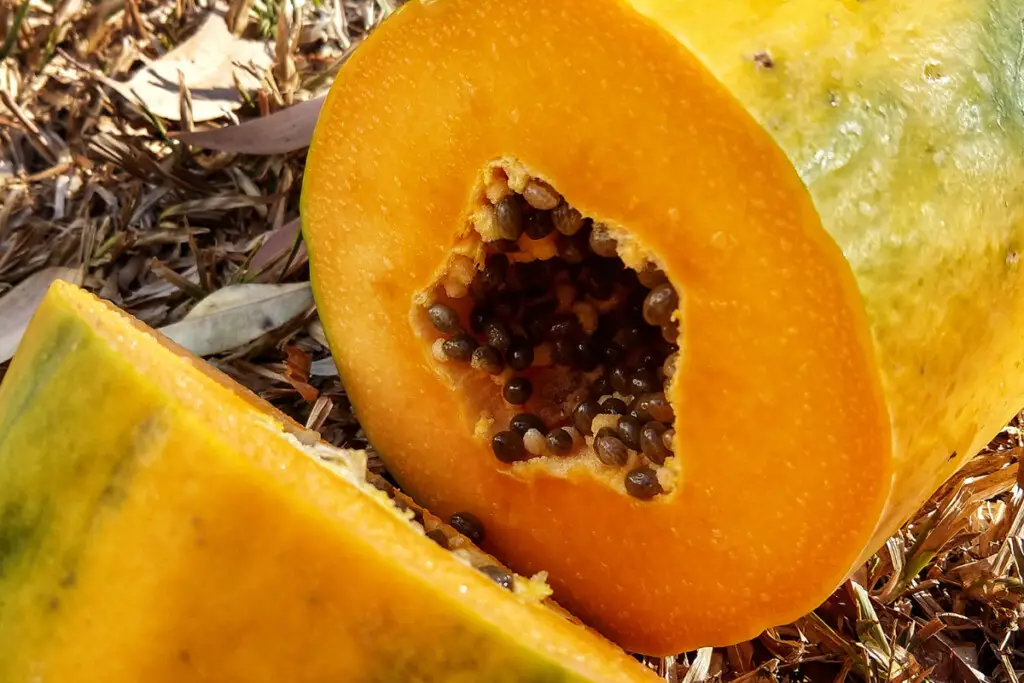
Papayas are probably the most common Sri Lankan fruits because they are so easy to grow and the papaya plants can produce all year round in a hot tropical climate. Papaya grows like weeds where the abundant black pips are discarded.
Green, unripe papayas can also be consumed making this plant a very useful survival plant. Famously, green papaya is used in the spicy Thai dish, som tum.
You will literally see the tall plants, crowned with fruit, everywhere. Papayas can be male or female, so it’s quite likely, if you see a papaya tree without fruit, it will be male.
Australians tend to call papayas paw paws, they’re not. A paw paw is a different plant from North America.
Would you save this to Pinterest? Click the red sharing button. Thanks.
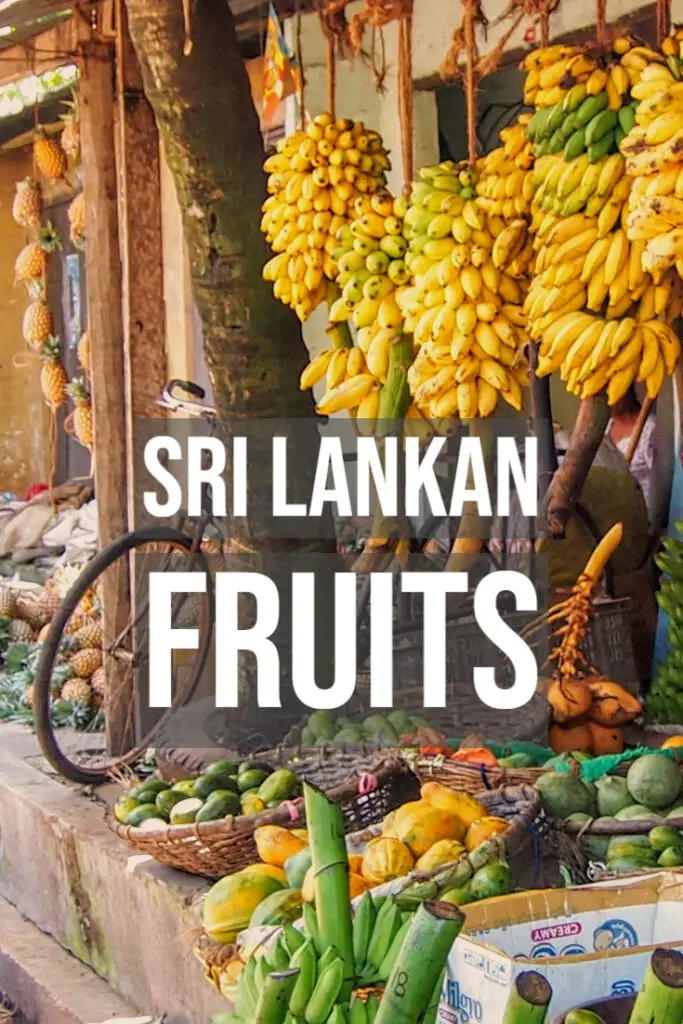
Rare Sri Lankan Fruits
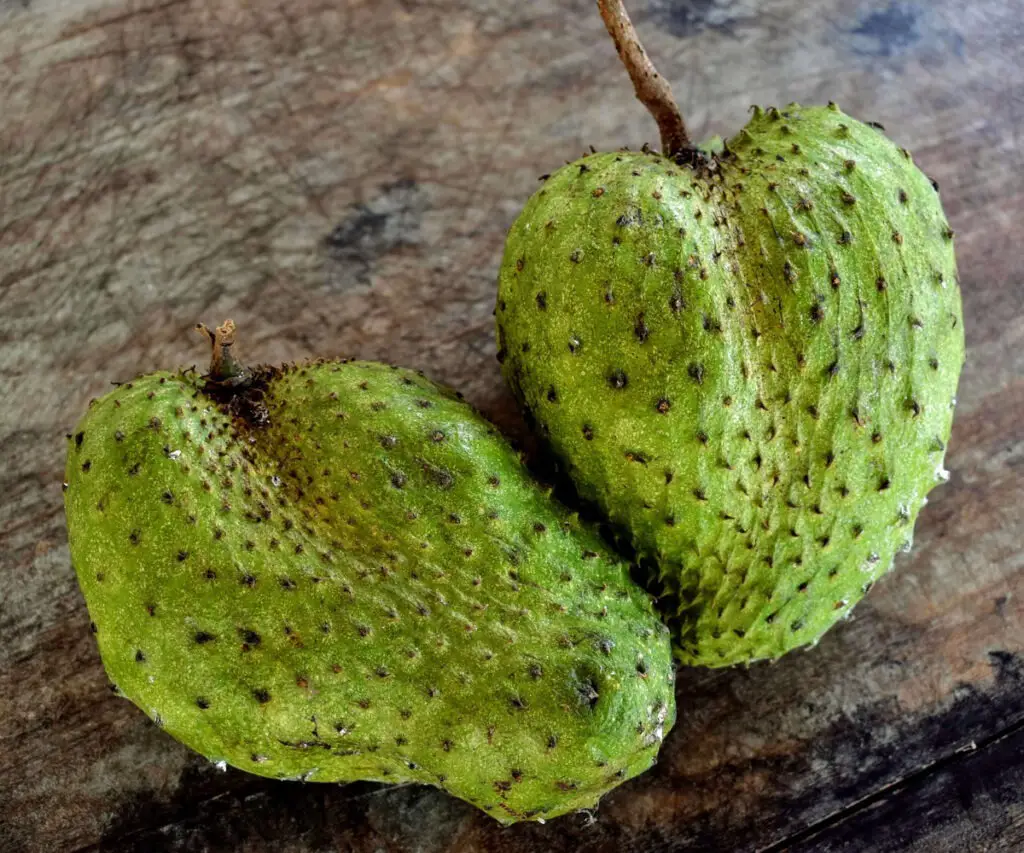
There are various wild, native, and indigenous fruits in Sri Lanka which are rare due to threatened habitats and lesser popularity. These include fruits listed here such as bael, masan, anoda (Soursop, or graviola, the fruit of Annona muricata), mora, himbutu (Chinese salacia, Salacia chinensis), nelli, katu, veralu (Ceylon olive) and lawulu (eggfruit, Pouteria campechiana) .
Bael, also known as belli is Aegle marmelos, commonly known as Bengal quince, golden apple, Japanese bitter orange, stone apple or wood apple is native to the Indian subcontinent and is found in Sri Lanka as a naturalized species. The skin of the fruit is a very hard brown green and the fruit pulp inside is orange and slightly sweet and aromatic. Bael fruit can be eaten fresh or used to make jam, syrups, puddings and desserts.
Other, more unusual fruits you will find in Sri Lanka are naminams, uguressa, wood apple, thambili ( king coconut) and stunning, pink dragon fruit.
Naminams are native to Malaysia but are sometimes (rarely) cultivated in Malaysia. This small kidney-shaped fruit grows around the base of the tree’s trunk and when ripe it is golden yellow. This fruit is sour and astringent and can be used to make a pickle. Naminam (or namnam) fruit, bark and leaves are said to have medicinal properties. The fruits, eaten fresh, are rich in Vitamin C.
Sapote including Mamey Sapote also grow in Sri Lanka although this fruit is native to Mexico and Central America.
One variety of mulberry is native to Sri Lanka, Mulberry macroura commonly called ‘Shatoot’ is a long, white, small growing mulberry bush or tree. This one is a good choice for home gardens as it stays relatively compact. Mulberry is malberi in Sinhla, malperi in Tamil.
More common fruits like passion fruit and avocado can also grow in Sri Lanka.
It is certainly possible to grow subtropical fruits in Sri Lanka, a grapefruit tree, lemon tree or orange should be a possibility, but we’ve not often seen these trees growing in Sri Lankan gardens or commercially as yet.
You’ll likely find an array of prepared fresh Sri Lankan fruits served as a platter alongside other Sri Lankan breakfast foods, otherwise, stop at a fruit market or stall and grab some local Sri Lankan fruits.
Thanks for reading and I hope you found the information you were looking for about Sri Lankan fruits. If not, tell us your questions in the comments section below and we’ll fill any gaps in this post.
If you'd like to hire a car during your stay, use this car rental comparison tool to find the best deal!
Please check out our Pinterest account for loads of food and recipes from around the world!

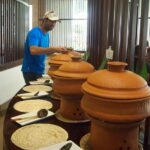

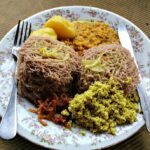

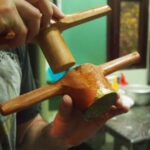
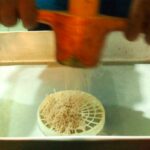

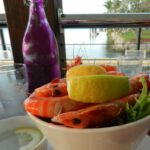

They are called plantains, bananas are of a different family. Sri Lanka has various types of plantains.
Avacardo and watermelon are also grown here in abundance. The cooler climate now offers locally grown strawberry as well.
Thanks for your comment Louisa. It’s all very similar to what we grow here in Australia in actual fact. Avocado is massively popular in Australia but I’ve never seen them used in Sri Lanka. How do you serve them there normally?
Avocado, Rambutan, Durian, mango, and banana are very popular in Sri Lanka and my favorites.
Avocado is a very popular fruit in Sri Lanka and you can find avocado in the local markets or can ask from villages.
You may visit Sri Lanka out of avocado season.
Thanks.
You never believe Sri Lankan fruits are unbelievably sweet and delicious. Why! It’s growing in tropical and perfect soil. Sri Lanka is a perfect place for fruits plantation. Mexican Papaya and pineapple you cannot compare with Sri Lankan fruits because Mexican fruits it not so sweet it’s waterish taste. The world didn’t know the value of Sri Lankan fruits because they never tasted.
I’ve never seen lychees in Sri Lanka yet.
Lychees are grown in Sri Lanka Sam but they’re a very seasonal fruit. We grow them here on our farm in Australia, and one day there’s none, then millions, then the next week its all over. You’d probably need to be in Sri Lanka in lychee season. For us that’s spring / late spring. Not sure what month it would be in the Northern Hemisphere.